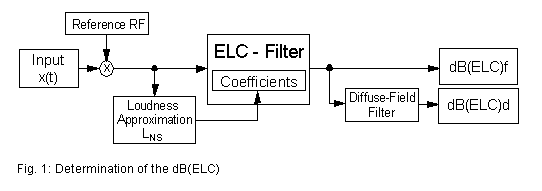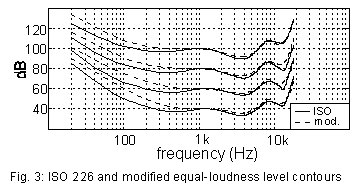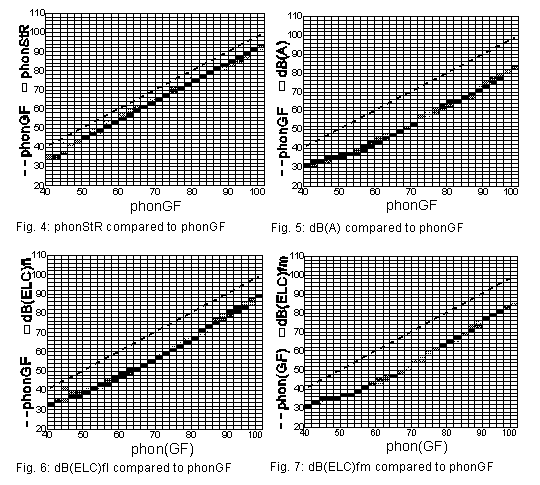dB(ELC) - A Proposal To Modify The dB(A)
Institute of Electronic Music, Graz, Austria
Dept. of Communications and Wave Propagation, Graz, Austria
1. INTRODUCTION
The dB(A) is a widely used measure for loudness. In contrast to the
dB(A), the proposed dB(ELC) (Equal Loudness Contours) uses four
different weighting filters. This kind of dynamic loudness-contour
adaption corresponds with the unequal weighting of different
frequency components at variable sound pressure levels. The idea
originates from the 1930s. At that time, it would have been too much
technical effort to implement a real-time dynamic loudness-contour
adaption. As a compromise, three different weighting contours, A, B
and C were introduced and one of these three filters was intended to
be used, depending on the range of sound pressure levels. At the end
of the 1960s, the dB(A) was chosen as the preferred measurement
quantity. Regarding this fact, the dB(ELC) is based upon the dB(A).
2. CALCULATING THE dB(ELC)
Fig. 1 shows the flow diagram of the proposed dB(ELC)-device.

The input x(t) can be assigned to various loudness levels by adjusting the reference factor RF. An approximation of the loudness level (LNS) is used to select the appropriate ELC-filter (inverse 40, 60, 80 or 100 phon contour) which is implemented as a recursive filter. To distinguish between free-field and diffuse-field levels, the output of the ELC-filter is additionally filtered with a diffuse-field filter. This results in two different measurement quantities, the dB(ELC)f for free- field conditions and the dB(ELC)d for diffuse-field conditions. The approximation of the loudness level LNS is shown in Fig. 2:

A ‘dominant frequency’ fd is obtained by using the difference
between unweighted and A-weighted sound level dBdiff and the
dB(A)-transfer function. This process presumes input signals with one
dominant frequency component. The actual signal bandwidth is not
taken into account. For an approximation of the loudness, this
simplification is tolerable. Making use of the dominant frequency fd
and the unweighted sound level, the loudness approximation is
determined with a table look-up containing the equal loudness level
contours.
Several authors have found considerable deviations from the equal-
loudness level contours fixed in ISO 226 [1-5]. These results led us
to develop modified phon-contours (Fig. 3). The modifications are
mean values of recent re-eximinations and will be replaced as soon as
a new standard is published. The additional distinction between ISO
and modified equal-loudness contours results in four different
measuring quantities: dB(ELC)fI (free-field, ISO 226), dB(ELC)dI
(diffuse-field, ISO 226), dB(ELC)fm (free-field, modified), dB(ELC)dm
(diffuse-field, modified).

3. ANALYSIS AND RESULTS
The difference between dB(ELC) and dB(A) is more than 10 dB for
3% of the analysed sounds [6]. These pronounced deviations led us
to investigate the differences between dB(ELC) and two more
sophisticated methods for calculating loudness levels. Fifteen
thousand signal frames of industry and traffic noise, each 125 ms
long, were randomly selected. Most of the selected sounds were
broadband with strong noise components. A distinction between free-
field and diffuse-field dB(ELC)-values can be ignored because the
differences between dB(A) and dB(ELC) are much more prominent
than the free-field - diffuse-field differences. Therefore, dB(ELC)d-
quantities were not further investigated.
For each frame the dB(A), dB(ELC)fI, dB(ELC)fm, phonGF (Zwicker´s
method for calculating loudness levels [7]) and phonStR (Stevens´
method for calculating loudness levels with third band levels and
Robinson’s modification [8]) were calculated. The distributions of the
measuring quantities versus phonGF are shown in Figures 4-7.

For example, column 1 in Fig. 4 shows the phonStR distribution for
frames whose phonGF-values are between 40 and 42 phonGF. The
dashed lines indicate the phonGF comparison.
The mean value of the phonStR is roughly 5 phon below the phonGF
(Fig. 4) as reported in [8]. There is no linear relation between the dB-
values (dB(A), dB(ELC)fI, dB(ELC)fm) and phonGF (Fig. 5-7). The
mean differences are larger because the increasing loudness due to
larger signal bandwidths are not considered in the dB-values. The
deviations are approximately the same for both the phonStR and the
dB quantities.
4. DISCUSSION AND CONCLUSIONS
- In contradiction to the dB(A), the proposed dB(ELC) takes into
account the entire hearing area. Depending on the absolute level and
the specific frequency content of a sound, the differences between
dB(A) and dB(ELC) can be significant (about 10 dB [6]).
- After converting the four quantities dB(A), dB(ELC)fI, dB(ELC)fm and
phonStR to phonGF (raising the mean value to the phonGF level),
there is no stronger correlation between phonStR and phonGF than
between the dB-quantities and phonGF. The expected tighter
correlation between quantities, which take into account the
dependancy of loudness on signal bandwidth (phonGF and phonStR),
can not be proved for the analysed sounds.
5. ACKNOWLEDGEMENT
This study was supported by the Austrian Science Foundation (FWF).
6. REFERENCES
[1] H. Fastl, A. Jaroszewski, E. Schorer, E. Zwicker, ‘Equal Loudness
Contours between 100 and 1000 Hz for 30, 50, and 70 phon’,
Acustica Vol. 70, pp. 197-201, 1990
[2] ‘Acoustics - Normal Equal-Loudness Level Contours’, ISO 226:
1987 (E), pp. 20-27
[3] Y. Suzuki, T. Sone, ‘Frequency Characteristics of Loudness
Perception: Principles and Applications’, Sixth Oldenburg Symposium
on Psychological Acoustics, pp. 193-221, 1993
[4] M.F. S&#oslash;rensen, ‘Equal Loudness Level Contours for Frequencies
20-1000 Hz at 10, 20, 40, 60, 80 and 100 Phon Levels’, Inter Noise
94, Yokohama-Japan, pp. 1073-1075, 1994
[5] H. Takeshima, Y. Suzuki, M. Kumagai, T. Sone, T. Fujimori,
‘Subjektive and Objektive Transformation Level between Free-Field
and Diffuse-Field in Equal-Loudness Level Contours’, Inter Noise 94,
Yokohama-Japan, pp. 1077-1080, 1994
[6] M. Pflueger, R. Hoeldrich, W. Riedler, ‘dB(ELC)-Dynamische
Phonkurvenanpassung als Erweiterung des dB(A)’, DAGA, 1996,
Bonn
[7] ‘Berechnung des Lautstärkepegels aus dem Geräuschspektrum -
Verfahren nach E. Zwicker’, DIN 45631, 1967, compare: ‘Method for
calculating loudness level’, ISO 532 - 1975 (E) p.44-55
[8] A. Schick, ‘Schallbewertung - Grundlagen der Lärmforschung’,
Springer-Verlag, Berlin Heidelberg, 1990
© 2000 zuletzt geändert am 26. Jänner 2000.

